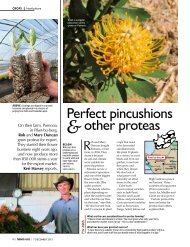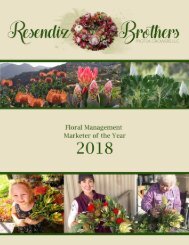Sunset-Article-December-2014
You also want an ePaper? Increase the reach of your titles
YUMPU automatically turns print PDFs into web optimized ePapers that Google loves.
FAMILY SKI TRIPS<br />
OUR FAVORITE GIFTS!<br />
EXPERIENCE the WEST DECEMBER <strong>2014</strong> MAKE-AHEAD PARTY FOOD | LIVING CHRISTMAS TREES | FAMILY SKI TRIPS | OUR FAVORITE GIFTS<br />
SUNSET.COM<br />
FESTIVE<br />
COCKTAILS &<br />
MAKE-AHEAD<br />
PARTY FOOD<br />
P. 75<br />
Living<br />
Christmas<br />
trees<br />
Decorate<br />
now,<br />
plant later<br />
P. 41<br />
DECEMBER <strong>2014</strong><br />
VISIT US AT SUNSET.COM<br />
100<br />
Fresh<br />
Holiday<br />
Ideas<br />
MAKE<br />
THIS<br />
WREATH<br />
P. 46
The otherworldly flowers<br />
that are taking over the West—and the<br />
farmer who loves them<br />
BY JOHANNA SILVER<br />
photographs by thomas j. story
From left: Grevillea;<br />
king protea<br />
(P. cyna roides).<br />
<strong>Sunset</strong> 69
I’m riding in Ismael “Mel” Resendiz’s<br />
truck, my knuckles white from gripping<br />
the handle above the door. I’d<br />
been warned about the rough cliffs at<br />
Resendiz Brothers Protea Growers, in San Diego<br />
County. These warnings feel entirely insufficient. The<br />
roads are so narrow that I lean toward the center of the<br />
car, terrified that my weight could be the difference<br />
between safety and a long tumble down to the bottom<br />
of the valley. Adding to my fear is the .22 rifle in the<br />
back, “for rattlesnakes,” Mel says.<br />
He stops the truck, and we climb toward the plants.<br />
There aren’t even terraces to buffer the slope (“They<br />
waste too much land,” Mel says). He shows me how to dig<br />
my heels in the crusty soil and walk up sideways. I feel<br />
like a baby goat that can’t find its footing. Then, through<br />
the mass of shrubby plants, my eyes catch a glimmer of<br />
what we’re here to see—a delicate protea flower.<br />
Proteas are among the oldest flowering plants on the<br />
planet, with fossils dating back 300 million years. The<br />
family takes its name from the shape-changing Greek<br />
god Proteus. It’s large and diverse—there are more than<br />
70 genera, which include large-flowered Banksia, spiderlike<br />
Grevillea, pincushion (Leucospermum) flowers,<br />
even macadamia nuts. “I can see a flower and be able to<br />
say, ‘Oh, yeah—that’s a protea,’ ” says Marc Johnson,<br />
resident protea expert at the San Francisco Botanic Garden.<br />
“They look like aliens.”<br />
On Mel’s steep parcel, I’m captivated by the ‘Fiesta’, a<br />
hybrid protea. The flowers form 3-inch-wide cylinders<br />
that fade from deep to pale pink—downy fluffs that look<br />
like pink owl heads perched atop rangy shrubs.<br />
“I thought they were so fancy,” Mel says, recalling his<br />
first encounter with proteas in 1981. He grew up in Querétaro, Mexico, leaving<br />
school after the fifth grade to cut sugarcane and pick cotton, two of the most grueling<br />
jobs in agriculture. After immigrating north in search of work, he landed in<br />
Southern California, where he discovered the flowers. He worked with two of the<br />
state’s most experienced protea growers, Howard Asper Sr. and Peter Sacks, then<br />
slowly built his farm by buying parcels of land—10 acres here, 13 there. Today,<br />
Mel’s protea farm extends over 150 acres and supports 25 employees, including<br />
his brothers Porfirio, Ramon, and Raul; his wife, Amparo; and his son, Ismael Jr.<br />
Proteas thrive in just a few areas in the world, Northern<br />
San Diego County and Maui being the centers of<br />
production in the United States. Native to the Southern<br />
Hemisphere, with the largest concentration in Australia<br />
and South Africa, most have evolved in nutrient-poor<br />
soils and dry summers. Too much water and any fertilizer<br />
can kill them—Mel barely feeds his and waters them<br />
by a drip system (which he laid by hand across those<br />
Lettering by Claudia De Almeida
“This isn’t your traditional<br />
flower farm. It’s more like a quilt<br />
on a mountain.”<br />
—KASEY CRONQUIST, CEO, CALIFORNIA CUT FLOWER COMMISSION<br />
crazy cliffs) every five to eight days. Proteas need perfect<br />
drainage, sunshine, and coastal breezes. In fact, they’re<br />
about the only thing that can be cultivated on these hills.<br />
Lucky for him, the demand for proteas has reached<br />
fever pitch. “I’ve never sold so many as I have in the past<br />
two years,” says Mel, who keeps buying more land to expand<br />
the farm. “It’s like a giant race to grow and harvest.”<br />
Around Valentine’s Day, he ships up to 10,000 stems a<br />
day. That’s a far cry from his early days spent cultivating<br />
proteas on other people’s land. “We’d have to throw out<br />
more than half the flowers when the owner came to visit,”<br />
he says. “We didn’t want him to see how many we<br />
couldn’t sell.” Debra Prinzing, author and founder of<br />
SlowFlowers.com, explains: “Proteas got stuck in this<br />
tropical ’80s look that went out of fashion, but they’ve<br />
been able to break out. They can look cottagey or totally<br />
Fiery orange<br />
‘Tango’ pincushion<br />
(Leucospermum)<br />
flowers erupt<br />
at the Resendiz<br />
Brothers farm in<br />
Rainbow, CA.<br />
SunSet ❖ DeCeMBeR <strong>2014</strong> 71
modern.” Plus, proteas bloom in the off-season, “filling the role of that dramatic<br />
dahlia that you can’t get locally in the middle of winter,” she says.<br />
Despite the climbing demand for the flowers, it’s surprisingly difficult for<br />
farmers to get their hands on even a fraction of the varieties. Seeds, often collected<br />
abroad by people like Johnson—who travels with a USDA permit to<br />
bring plant material back to this country—can have germination rates as low<br />
as 10 percent. Others won’t sprout unless they’ve gone through a fire (Johnson<br />
sometimes uses a blowtorch to blast seeds before sinking them into a potting<br />
medium). Mel arranges deals with a handful of protea growers in Australia<br />
and South Africa to ship him varieties he doesn’t have. He’s also taken to<br />
creating his own—cross-pollinating flowers to come up with pincushion hybrids,<br />
and grafting proteas he likes onto more vigorous rootstocks. (His favorite<br />
creation: bright red ‘Eileen’.) Over the past 30 years, he’s invented 15 new<br />
varieties, much lower than breeding programs for other plants.<br />
Some proteas are so sought after<br />
that they have become the targets<br />
of horticultural crime. Rare species<br />
of blushing bride (Serruria florida),<br />
which have tissue paper–like flowers,<br />
were stolen from the San Francisco<br />
Botanical Garden. And people<br />
have snuck onto Mel’s fields<br />
late at night to snip cuttings (not a<br />
great idea—remember that gun?).<br />
Mel is territorial over his crops<br />
because, besides being his livelihood,<br />
they’re also his loves. “You<br />
have to see him make a bouquet,”<br />
says Diana Roy, business manager<br />
at Resendiz Brothers. “It’s the real<br />
Mel.” So once we’re down from the<br />
cliffs, we head to the packing shed.<br />
Mel takes his spot at a table and<br />
starts grabbing stems from harvest<br />
buckets. Just like the plants themselves,<br />
rugged and delicate merge<br />
together as this burly farmer builds<br />
a floral arrangement.<br />
“I don’t always make it to the<br />
shed,” Mel confesses. “Especially in<br />
spring, when the flowers are just so<br />
beautiful, I make bouquets right in<br />
the fields.” You’ve got to be kidding<br />
me, I think to myself. Should we go<br />
shoot some rattlesnakes or something?<br />
But as I’m about to poke fun,<br />
he hands over the arrangement,<br />
and like any recipient of a protea<br />
bouquet, I’m speechless.<br />
DIGITAL BONUS See more<br />
breathtaking proteas:<br />
sunset.com/proteas.<br />
where to buy<br />
Unless you have the perfect conditions<br />
for proteas (plenty of sunshine, dry<br />
summers, and fast-draining soil),<br />
enjoying the blooms as cut flowers is<br />
your best bet. Resendiz Brothers Protea<br />
Growers, in Rainbow, California<br />
(resendizbrothers.com), is currently<br />
wholesale only, but is slated to launch<br />
The Protea Store for retail orders of<br />
Protea along with Banksia, Grevillea,<br />
Leucadendron, Leucospermum, and<br />
others by early 2015. Western farmers<br />
who sell to the public: Rainbow Protea<br />
(rainbowprotea.com), also in San Diego<br />
County, and Kula Farm Flowers<br />
(kulafarm.com), on Maui.<br />
cut-flower care<br />
Sturdy stems and long-lasting blooms<br />
make proteas the perfect cut flowers.<br />
Extend their life in a vase by following<br />
these steps: (1) Snip off about 1 ⁄4 inch<br />
from the end of the stem. (2) Strip<br />
stems of any leaves that will be below<br />
the water’s surface. (3) Add 1 ⁄4 teaspoon<br />
of bleach per quart of water<br />
to prevent algae from growing—or<br />
change water daily. (4) Keep out of<br />
direct sunlight.<br />
how to dry<br />
Faded blooms often dry without losing<br />
any petals or leaves, and they can last<br />
for years. Stand the stems in an empty<br />
bucket or vase, or hang them upside<br />
down (they’ll lose their shape if stored<br />
in a pile or on a flat surface). Expect<br />
the colors to fade to shades of tan.<br />
From top:<br />
King protea (P. cynaroides),<br />
Leucospermum ‘Flame Giant’,<br />
and Banksia. Opposite:<br />
Mel with an arrangement<br />
he made in the fields.
“I’ve built my<br />
whole life around<br />
these flowers.”<br />
—MEL RESENDIZ















